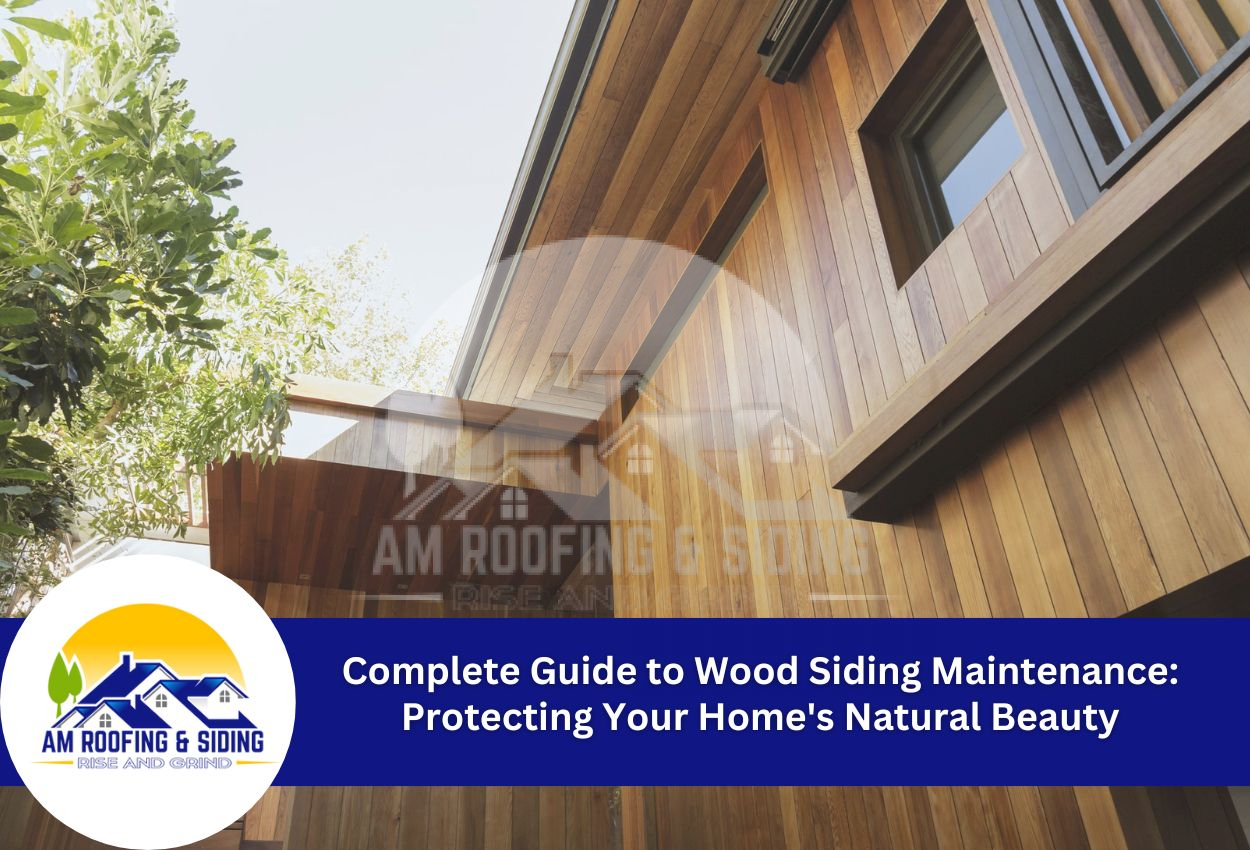Wood siding brings natural warmth and character to Central Ohio homes that few other materials can match. However, this beauty comes with responsibility — maintenance is essential to preserve both appearance and structural integrity. Without regular care, wood siding can quickly deteriorate from exposure to Ohio’s variable climate, leading to repairs or premature replacement. From harsh winters to humid summers, these seasonal changes present unique challenges for homeowners with wood exteriors.
Different wood siding varieties require specific maintenance approaches. Cedar siding, popular for its natural resistance to decay, needs different treatment than pine or redwood options. Engineered wood products, while more durable than traditional wood, still benefit from protective maintenance to maximize their lifespan. Understanding these differences helps homeowners develop maintenance routines tailored to their specific siding type.
Effective wood siding maintenance involves regular inspections, prompt repairs, cleaning, and applying protective treatments. These preventive measures help identify signs of potential issues, extend the siding’s lifespan, and maintain your home’s curb appeal. With the right knowledge and seasonal maintenance schedule, homeowners can protect their investment and keep their wood siding looking beautiful for decades.
Wood Siding Inspection Techniques
Regular inspections are the foundation of wood siding maintenance. For Central Ohio homeowners, it is generally recommended to examine your siding at least twice yearly when weather conditions are mild and problems are easier to spot. During these inspections, look closely for signs of rot by gently probing suspicious areas with a screwdriver. Soft spots indicate decay that requires immediate attention.
Check for warping, splitting, or cupping of boards, which often signals moisture problems. Examine areas around windows, doors, and where siding meets the foundation for water intrusion pathways. Don’t overlook signs of insect activity, including small holes, sawdust-like frass, or mud tubes that may indicate termites or carpenter ants have taken residence.
Document your findings using a simple checklist and photos to track changes over time. When prioritizing repairs, address structural concerns first — any issue allowing water infiltration, active insect infestation, or compromising the building envelope deserves immediate attention. Cosmetic issues like fading, minor cracks, or small stains can typically wait for scheduled maintenance periods.
Creating a seasonal maintenance calendar helps track when specific tasks should be done. For many Ohio homeowners, spring inspections help identify winter damage, while fall assessments ensure the siding is properly sealed before cold weather returns. This can extend your wood siding’s lifespan and preserve your home over time.
Cleaning Methods That Preserve Rather Than Damage
Proper cleaning is essential for wood siding maintenance, but using harsh methods can cause more harm than good. For Central Ohio homes, gentle cleaning approaches help preserve wood integrity while effectively removing dirt and biological growth. Start with the least aggressive method: a soft-bristled brush and mild cleaning solution of water mixed with oxygen bleach or specialized wood cleaner. This combination effectively removes surface dirt without stripping protective finishes.
When washing wood siding, it is important to use a garden hose rather than a pressure washer, which can damage the wood. Always wash in the direction of the wood grain and avoid lingering in one spot to prevent etching or splintering the wood siding.
For removing mold, mildew, and algae safely, mix one part oxygen bleach with four parts water. Apply this solution with a pump sprayer, allow it to sit for 10 to 15 minutes, then gently scrub with a soft brush. Thoroughly rinse with clean water afterward. Avoid chlorine bleach, which can damage wood fibers and harm surrounding vegetation. For stubborn growth, borax solutions provide an eco-friendly alternative that continues to inhibit future biological growth.
Between deeper cleanings, remove dust and debris using a soft brush or a gentle rinse with a garden hose. This simple wood siding maintenance step prevents buildup that can trap moisture against the surface and accelerate deterioration.
Effective Repair Strategies for Damaged Wood Siding
Even with diligent maintenance, wood siding will eventually need repairs. Addressing minor issues quickly prevents them from developing into major problems that compromise your home’s exterior. For small cracks less than 1/4 inch wide, apply exterior-grade wood filler, allow it to dry completely, then sand smooth before priming and painting. Loose boards should be secured immediately by replacing damaged nails with corrosion-resistant screws that provide better holding power against Ohio’s freeze-thaw cycles.
Nail pops, where fasteners push outward due to wood movement, require countersinking the nail deeper into the wood and adding a new fastener nearby. For boards showing early signs of rot, remove affected sections by cutting back to sound wood, then treat the area with borate solution to prevent further decay before patching with wood epoxy. Water stains can often be remedied with oxalic acid cleaners specifically formulated for wood restoration.
Some damage signals the need for professional intervention. Extensive rot affecting multiple boards, significant warping or buckling across large sections, or signs of structural water damage behind the siding all warrant calling experienced contractors. Signs of widespread insect infestation, particularly termites, require both pest control specialists and siding professionals to address the damage. When choosing a contractor for major wood siding repairs, look for specialists with specific experience working with your siding type and who understand the local weather in Central Ohio.
Protective Treatments and Finishes for Longevity
Selecting the right protective treatment for your wood siding is crucial for withstanding Ohio’s challenging weather conditions. Each option offers different benefits: sealants provide a clear protective layer that highlights wood’s natural beauty while offering moderate protection, stains penetrate the wood fibers to add color while guarding against moisture and UV damage, and paints create a complete barrier against the elements, offering the longest-lasting protection. Cedar and redwood accept stains beautifully, while pine and fir often benefit from the additional protection of quality paint systems.
Timing your application is just as important as the product you choose. In Central Ohio, schedule exterior treatments during moderate temperatures between 50 and 85 degrees Fahrenheit with low humidity and minimal chance of rain for at least 24 hours afterward. Spring and early fall typically offer ideal conditions. Always apply protective finishes to thoroughly cleaned, dry wood with moisture content below 15% — a moisture meter can help verify this important requirement.
The application techniques you use will impact the effectiveness of the treatment. For stains and sealants, work in small sections, applying with the grain using natural-bristle brushes for oil-based products or synthetic brushes for water-based options. Ensure even coverage without allowing excess product to pool on the surface. Most treatments require a maintenance coat every few years, though south and west-facing walls may need attention sooner due to increased sun exposure. This regular renewal of protective barriers is essential for maximizing your wood siding’s lifespan.
Seasonal Maintenance Calendar for Ohio’s Climate
Maintaining wood siding in Ohio requires adjusting your maintenance approach to match the region’s seasonal challenges. Creating a structured maintenance calendar helps protect your investment year-round while addressing the specific threats each season brings to your home’s exterior.
In spring, focus on thorough cleaning to remove winter’s accumulated dirt and salt residue. April and May provide ideal conditions to inspect for freeze-thaw damage and repair any boards that have cracked or warped during winter. Apply protective treatments once temperatures consistently reach 50 to 70 degrees Fahrenheit and humidity levels are moderate. Summer maintenance should include checking for insect activity, particularly around eaves and near landscaping. June inspections help identify areas where expanding wood might have created gaps that need sealing before humidity peaks in July and August.
Fall preparation is critical for wood siding protection before winter arrives. September and October provide perfect opportunities to clean gutters and ensure proper drainage away from siding. Apply water-repellent treatments while temperatures remain moderate. Check all caulking around windows, doors, and joints, replacing any that show signs of cracking. For winter protection, ensure all wood surfaces are sealed to prevent moisture infiltration during freeze-thaw cycles common to Central Ohio. Installing snow guards on roofs can prevent sliding snow and ice from damaging siding below.
This approach to seasonal wood siding maintenance addresses Ohio’s specific climate challenges and significantly reduces long-term repair costs while preserving your home’s appearance and structural integrity.
Enhancing Wood Siding Performance and Aesthetics
Beyond basic maintenance, thoughtful landscaping decisions and modern protective innovations can significantly extend your wood siding’s lifespan. These proactive measures not only preserve your home’s exterior but can enhance its beauty and structural integrity for years to come. Strategic landscape planning and cutting-edge products can provide additional protection for your wood siding.
Proper landscaping starts with ensuring adequate drainage around your home’s perimeter. Soil should slope away from your foundation at a minimum 6-inch drop over 10 feet to prevent water from collecting near your siding. Consider installing French drains in problem areas where water naturally collects. When planting near your home, maintain at least 2 feet of clearance between shrubs and siding to promote airflow and prevent moisture retention. Trees should be trimmed regularly to keep branches from rubbing against siding and creating abrasion damage.
Today’s wood siding protective treatments have evolved significantly, offering superior performance compared to products available even a decade ago. Water-based penetrating stains containing zinc provide exceptional UV protection while allowing wood to breathe naturally. For maximum protection, consider installing rain screens, systems that create a ventilated gap between siding and the water-resistant barrier. This modern approach dramatically improves moisture management by allowing drainage and promoting airflow behind wood siding, addressing one of the primary causes of premature deterioration in Ohio’s humid climate.
Expert Wood Siding Maintenance from AM Roofing & Siding
Maintaining the aesthetic and structural integrity of your wood siding is crucial, especially in Ohio. Don’t let minor issues like cracks or moisture intrusion escalate. At AM Roofing & Siding, we specialize in extending the lifespan of your wood siding through professional maintenance techniques tailored to Ohio’s unique weather conditions. Our experts are adept at handling everything from routine inspections to applying the best wood siding protective treatments.
To prevent any irreversible damage and to keep your home looking its best, call us today at (740) 974-8268 to schedule your maintenance service. Let AM Roofing & Siding help you preserve the natural beauty and durability of your wood siding.

